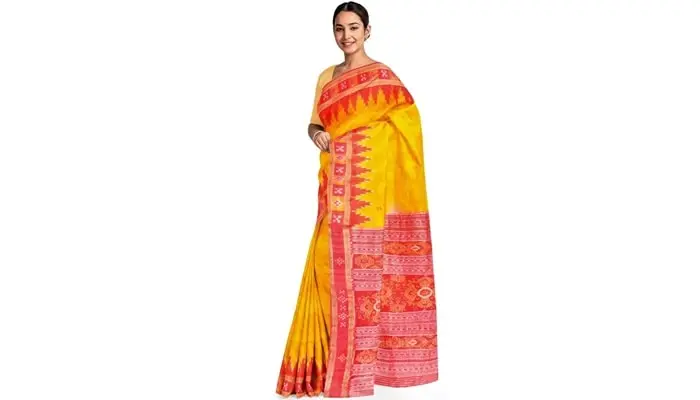Odisha is a land of temples, mainly famous for the Jagannath and Konark temples. It is one of the most prominent states of India. This state is well known for its sculpture, historical monuments, dance form and music. In ancient times, Odisha was known as Utkala, Tosala, Odra, Kosala, Tosali, Kalinga and Orrisa. Even the traditional dressing style is no less than any other state. Let us quickly check out some of Odisha’s traditional dresses.
Traditional Dress of Odisha for Women
Women in Odisha love wearing a saree. These are not just simple sarees but famous ones like the Khandua, sambhalpuri ikat, Sonepuri, Pasapali, Berhampur, and Kataki saree.
1. Khandua Saree

These sarees have a distinct metallic accent with curvy edges. Khandua gives the wearer a sense of courage and bravery. They are composed of Malda or soft silk with a highly detailed design. Women in Odisha wear this saree during special occasions like festivals and weddings. Borders of the saree are embedded with simple ikat work.
In contrast, the pallav consists of intricate ikat work. These sarees are designed in patterns of orange, red and yellow. Moreover, the pallav and borders are generally crimson, blue and black, which elevates the overall look.
2. Sambhalpuri ikat
Sambhalpuri ikat sarees are made using a special technique called Bandhkala. This saree has a unique nature-inspired design like rudraksha, chakra or flowers. The warp and weft yarns are tie-dyed first and then weaved. The more effort it requires, the more expensive the price.
3. Sonepuri
Sonepuri or bomkai is a blend of soft silk embroidery, especially on the border and pallav. The saree is influenced by tribal art, and the motifs are nature-inspired. This saree arrives in blue, orange, red, yellow and black. Pallav are weaved with highly elevated patterns, while the body of the saree has tiny ikat motifs.
4. Pasapali
Pasapali is an ikat headwoven saree originating from Bargarh, Orissa. This saree is made of double ikat, creating a checkboard pattern, whereas the borders appear redefined. Pasapali displays vivid colours and patterns.
5. Berhampur
Berhampur, famous as the silk city of India, is home to this legendary Patta silk saris. These classic sarees drape into a temple pattern. They are the pride of Odisha state and are worn at wedding functions.
Other than sarees, Odisha women are also seen in kurtas with Uttariyo or duppattas. The uttariyo is a larger piece of cloth used to cover the bride’s head. It is embedded with pretty zari work. Uttariyo looks best with a matching hat.
Traditional Dress of Odisha for Men
1. Sambhalpuri Kurtas
Men in Odisha wear variations of sambhalpuri kurtas in different colours, fabrics, and styles. These resemble regular kurtas with sleeves, light patchwork, and a small square design.
2. Kurta with Dhoti or pyjamas
In some rural regions of Odisha, men wear cotton kurtas with dhoti draped around the waist. The dhotis in Odisha are unique and come in alluring brick colour borders. The traditional dress of Odisha is incomplete without a pyjama. They are usually plain white.
3. Sherwani
Sherwanis are designed exclusively to give a classic look to the groom. The attire is the same as in another state, with a velvet kurta and expensive stone embedded in it. The kurta is paired with a turban and a pyjama at the bottom.
Traditional tribal dress in Odisha
Tribal people in Odisha wear clothes according to their clan’s social status, like priests, clan chiefs, or revenue collectors. For example, the clan chief wears “Gamango,” representing heroism and dignity. The Bondos’ “Rings” and the Dangarias’ embroidered shawl are essential in their culture. Dangria shawl is connected to the marriage bonds of a couple of shares, whereas Lanjia Saora’s dancing costumes define their rich heritage.
Odisha Traditional Dancing attire
Odishi dancing costume is not a simple dress, to be precise, but a representation of the great Odisha’s culture. The traditional dance form ‘Odissi’ has touched people with its sensational moves over centuries. Anklets, tayila kapa, chokers, belts and bells are all part of the head and hair ornament work. These jewellery are made of pure gold and silver. Many art forms of Odisha originate from the Cuttack.
Conclusion
Handloom Weaving is one of the oldest businesses in India. Many weavers and artisans support this work. However, this has been slightly changed due to modern lifestyles. But the natives never miss a chance to showcase their talents during special occasions like the Durga Pooja.

